We may not have the course you’re looking for. If you enquire or give us a call on +44 1344 203 999 and speak to our training experts, we may still be able to help with your training requirements.
Training Outcomes Within Your Budget!
We ensure quality, budget-alignment, and timely delivery by our expert instructors.

Ethereum, often called the pioneer of Blockchain technology beyond Cryptocurrencies, has revolutionised the digital domain. Thanks to its innovative contract capabilities and robust ecosystem, its versatility extends beyond mere financial transactions. However, navigating the world of Ethereum, whether as a developer, investor, or enthusiast, can be a complex endeavour.
Navigate Ethereum Interview Questions with confidence using our curated list of essential questions & ace your discussion on this groundbreaking Blockchain platform.
Table of Contents
1) Understanding Ethereum
2) Ethereum Interview Questions and answers
3) Conclusion
Understanding Ethereum
Ethereum is a Blockchain platform that goes beyond traditional Cryptocurrencies. Ethereum's native Cryptocurrency, Ether (ETH), fuels transactions and computations on the forum. Its Blockchain is decentralised and maintained by nodes worldwide, ensuring security and trustlessness.
Ethereum's versatility has created a vibrant ecosystem, empowering developers to build decentralised finance (DeFi) protocols, non-fungible tokens (NFTs), and more. With Ethereum, the possibilities for innovation in finance, governance, and beyond are limitless, making it a driving force in the Blockchain revolution
Explore our comprehensive Blockchain Training course and unlock exciting opportunities and lead the way in the Blockchain revolution.
Ethereum Interview Questions and answers
The following are the Ethereum Interview Questions that will help you prepare better for the interview.
1) What is Ethereum?
Ethereum is a revolutionary Blockchain-based platform that has transformed the world of decentralised technology and digital finance. Founded by Vitalik Buterin in 2014, Ethereum serves as a decentralised and open-source ecosystem, enabling developers to create a broad spectrum of applications and Smart Contracts, all governed by a secure and transparent network.
At its core, Ethereum is more than just a Cryptocurrency; it is a decentralised computer that executes code, facilitating the creation of Decentralised Applications (DApps). Unlike Bitcoin, which primarily functions as a digital currency, Ethereum's primary purpose is to provide a platform for innovation.
Smart Contracts, one of Ethereum's groundbreaking features, are self-executing contracts with predefined rules, automating and ensuring the trustworthiness of agreements between parties without intermediaries.
2) Who is the founder of Ethereum?
Ethereum, the groundbreaking Blockchain platform, was conceptualised and founded by the visionary computer scientist and programmer Vitalik Buterin. Born in Russia in 1994, Buterin displayed exceptional talent in mathematics and computer science from an early age.
Vitalik Buterin's groundbreaking idea was to create a Blockchain that could not only support digital currency but also serve as a versatile platform for executing Smart Contracts and Decentralised Applications (DApps).
His innovation has profoundly impacted the Blockchain and Cryptocurrency space, fuelling a wave of innovation and sparking interest from developers, businesses, and organisations worldwide. As the co-founder and initial architect of Ethereum, Vitalik Buterin's contributions continue to shape the future of decentralised technology and the broader Blockchain ecosystem.
3) What is Ether (ETH)?
Ether (ETH) is a Cryptocurrency of the Ethereum Blockchain, serving as the primary fuel that powers the network's operations. It is a digital asset with various use cases within the Ethereum ecosystem. Ether has garnered significant attention and adoption in Cryptocurrencies and Blockchain technology
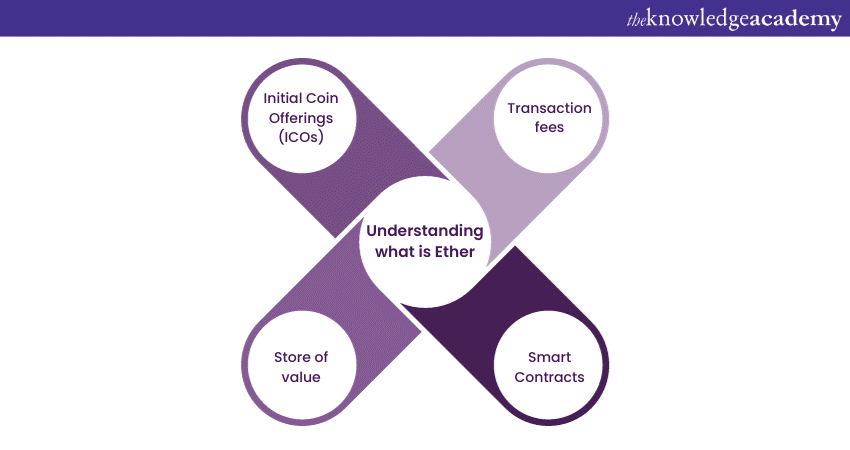
a) Transaction fees: Ether is used to pay transaction fees, known as gas, for executing actions on the Ethereum network. These actions include sending Ether, interacting with Smart Contracts, and deploying Decentralised Applications (DApps). Gas fees are essential to prevent spam and ensure the proper functioning of the network.
b) Smart Contracts: When developers create and deploy Smart Contracts on Ethereum, they often require Ether to function. Intelligent contracts may involve complex logic and require Ether to process and execute the code written in Solidity or other Ethereum-compatible programming languages.
c) Store of value: Many investors view Ether as a store of value, like Bitcoin. They purchase and hold Ether as a long-term investment, anticipating future price appreciation.
d) Initial Coin Offerings (ICOs): Ether has historically been used to participate in ICOs, where new Blockchain projects raise funds by selling their native tokens in exchange for Ether.
Register for our Bitcoin and Cryptocurrency Course course and acquire knowledge of the mechanics of bitcoin, bitcoin mining, and anonymity.
4) What is a Smart Contract?
An intelligent agreement is a self-executing digital agreement with predefined rules and conditions written in code. These contracts operate on Blockchain technology, most notably on platforms like Ethereum. Smart Contracts are designed to automate, verify, and enforce an agreement or transaction's terms without intermediaries, such as lawyers, banks, or notaries.
Here is how a Smart Contract works:
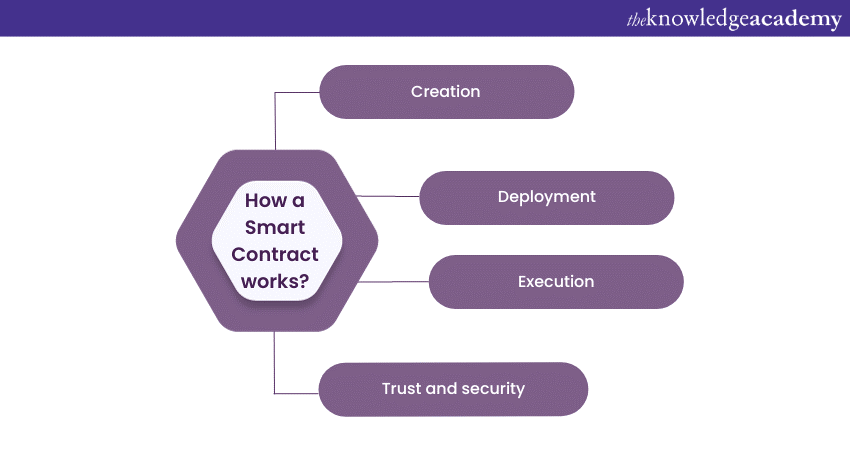
a) Creation: A developer writes the rules and conditions of the contract using a programming language like Solidity (Ethereum's primary intelligent contract language).
b) Deployment: The Smart Contract is deployed onto a Blockchain network, creating a decentralised and immutable version of the agreement.
c) Execution: When specific predefined conditions are met, such as a certain date or event, the Smart Contract automatically executes the agreed-upon actions. This can include transferring funds, updating records, or triggering other agreements.
d) Trust and security: Smart Contracts provide transparency, security, and trust, as the code is open for anyone to inspect, and contract execution is tamper-proof.
5) How does Ethereum differ from Bitcoin?
Ethereum and Bitcoin are both prominent Cryptocurrencies, but they differ significantly in their underlying purposes and capabilities:
a) Primary function:
Bitcoin (BTC) is primarily a digital currency designed to serve as a decentralised store of value and a medium of exchange.
Ethereum (ETH) is a Blockchain platform that goes beyond currency. It permits developers to create decentralised applications (DApps) and execute Smart Contracts, self-executing contracts with predefined rules.
b) Smart Contracts:
Bitcoin's scripting language is limited and primarily used for transaction functionality.
Ethereum introduced a Turing-complete scripting language, enabling the creation of complex Smart Contracts and DApps.
c) Blockchain purpose:
Bitcoin primarily focuses on financial transactions and is a digital alternative to traditional currencies.
Ethereum is a versatile platform for decentralised applications, allowing developers to make a broad spectrum of applications beyond just currency.
d) Development community:
Bitcoin has a more straightforward use case and extensive history, with a strong focus on security and decentralisation.
Ethereum has a vibrant ecosystem of developers creating DApps for various industries, including finance, gaming, supply chain, and more.
6) What is gas in Ethereum?
In Ethereum, "gas" refers to a unit of measurement for the computational labour needed to execute transactions and Smart Contracts on the network. It is a crucial concept that plays a vital role in providing the efficient and secure operation of the Ethereum Blockchain.
Here is how gas works in Ethereum:
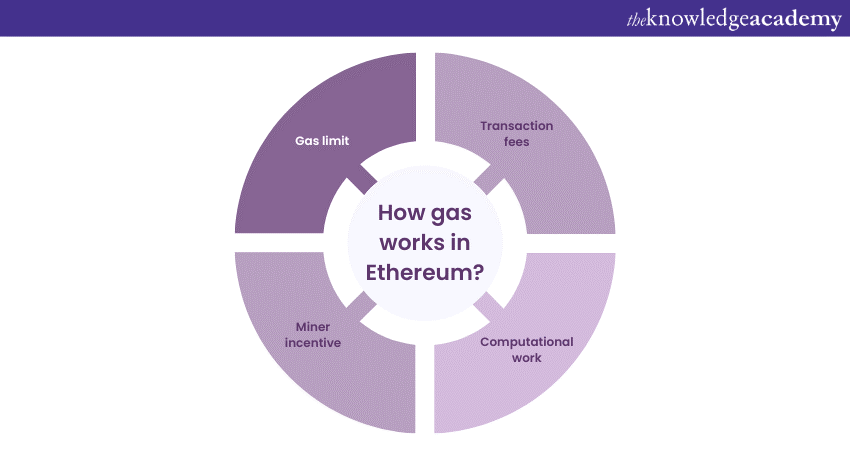
a) Transaction fees: When a user creates a marketing or executes a Smart Contract, they specify a gas limit and price. The gas limitation is the most significant amount of gas they are willing to consume, and the gas price is the quantity of Ether (ETH) they are willing to pay per unit of gas. Together, these determine the total transaction fee.
b) Computational work: Every operation on the Ethereum network, whether it is sending Ether, interacting with a Smart Contract, or executing code, consumes a specific amount of gas. More complex operations require more gas.
c) Miner incentive: These gas fees motivate miners who validate transactions and include them in blocks. They prioritise transactions with higher gas prices, ensuring they are processed quickly.
d) Gas limit: The gas limit prevents infinite loops or excessive resource consumption by limiting the amount of work a transaction can perform. If a transaction runs out of gas, it is reverted, and the user's Ether is refunded.
7) What is a hard fork in Ethereum?
A hard fork in Ethereum refers to a significant and incompatible change in the protocol's rules and consensus mechanism. It results in a divergence from the previous Blockchain version, creating two chains with different traditions and transaction histories.
Here is how a hard fork typically occurs in Ethereum:
a) Proposal: A hard fork is proposed to introduce substantial changes or upgrades to the Ethereum network. These changes can relate to security improvements, scalability enhancements, or changes in the Blockchain's operation.
b) Node consensus: For a hard fork to occur, most Ethereum nodes (computers running Ethereum software) must agree to adopt the new rules. This often involves miners, developers, and node operators reaching a consensus.
c) Activation: Once a consensus is reached, the hard fork is activated at a specific block height or number. The new rules govern one Blockchain branch from this point onward, while the previous authorities govern the other.
d) Result: After the hard fork, two separate Blockchains have their own transaction histories. Users and developers must choose which chain they want to follow and use.
8) Explain the concept of a Merkle Tree in Ethereum.
A Merkle Tree is a data structure used in Ethereum and other Blockchain systems to efficiently keep and confirm the goodness of transactions within a block. It is named after its inventor, Ralph Merkle. In Ethereum, Merkle Trees play a pivotal role in providing the safety and transparency of the Blockchain.
Here is how a Merkle Tree works:
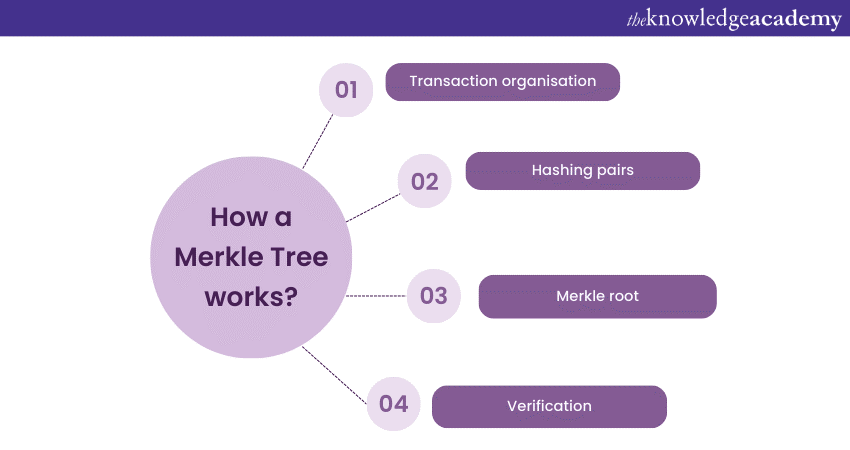
a) Transaction organisation: In each Ethereum block, multiple transactions are bundled together. To create a Merkle Tree, these transactions are organised into pairs.
b) Hashing pairs: The data of each pair is hashed using a Cryptographic hash function (usually SHA-256) to produce a unique hash value for each team. These hashes are then paired again and hashed until only one soup, known as the Merkle Root, is left.
c) Merkle root: The Merkle Root is a single hash value representing all the block transactions. It is included in the block's header, making it a fundamental part of its identity.
d) Verification: To verify a specific transaction within a block, a node in the Ethereum network only needs to know the Merkle Root and the transaction's position in the league. By following the path of hashes from the transaction up to the Merkle Root, the node can efficiently confirm the inclusion of the transaction without needing to process every transaction in the block.
9) What is the Ethereum Virtual Machine (EVM)?
The Ethereum Virtual Machine (EVM) is a crucial component of the Ethereum Blockchain, serving as a decentralised, globally distributed, and tamper-resistant computer. It is the runtime environment for executing Smart Contracts and decentralised applications (DApps) on the Ethereum network. It is pivotal in achieving Ethereum's goal of enabling trustless and self-executing agreements.
The EVM is sandboxed, which operates in an isolated environment to prevent malicious code from affecting the underlying network. Its deterministic nature ensures that contract execution yields identical results on every node, guaranteeing consensus and enabling the trust and security required for Blockchain-based applications.
10) How is Ethereum 2.0 different from Ethereum 1.0?
Ethereum 2.0, or Eth2 or Serenity, represents a substantial upgrade and evolution from Ethereum 1.0. The key differences are:
a) Consensus mechanism: Ethereum 1.0 primarily relies on Proof of Work (PoW) for transaction validation and block creation, which consumes significant energy and limits scalability. Ethereum 2.0 introduces a transition to Proof of Stake (PoS), where validators are determined to develop and validate blocks established on Cryptocurrency they hold and are willing to "stake" as collateral. This shift reduces energy consumption, increases network security, and improves scalability.
b) Scalability: Ethereum 1.0 faces scalability challenges, leading to congestion and high gas fees during periods of high activity. Ethereum 2.0 aims to solve this with shard chains, splitting the network into smaller chains (shards) to process transactions in parallel, significantly increasing capacity.
c) Beacon chain: Ethereum 2.0 introduces a new Beacon Chain, which coordinates validators, manages the PoS protocol, and facilitates communication between shard chains. It operates alongside the existing Ethereum 1.0 chain during the transition phase.
11) Explain the role of miners in the Ethereum network.
Miners play a vital role in the Ethereum network by performing several essential functions that ensure its security, integrity, and functionality. Their primary responsibilities include validating transactions, creating new blocks, and maintaining the Blockchain.
First, miners validate and process incoming transactions by verifying their accuracy and legitimacy. Miners also check for any potential issues, such as double-spending attempts.
Second, miners compete to solve complex mathematical puzzles through a process known as Proof of Work (PoW). The miner who successfully solves the puzzle benefits from creating a new block of transactions and adding it to the Blockchain. This process, known as "mining," also involves including a set of transactions in the league and appending it to the existing chain.
12) What are the main components of a transaction in Ethereum?
A transaction in Ethereum consists of several essential components:
a) Sender address: This is the Ethereum address of the person initiating the transaction, also known as the "from" address. It represents the user or entity sending Ether or interacting with a Smart Contract.
b) Recipient address: The recipient address, also called the "to" address, specifies the destination where the Ether or Smart Contract interaction is directed. It could be another user's address or a Smart Contract's address.
c) Amount: The amount of Ether transferred in the transaction, denominated in wei (the smallest unit of Ether). It signifies the value being sent from the sender to the recipient.
d) Gas limit: The maximum amount of computational work the transaction can perform. It prevents infinite loops or excessive resource consumption.
e) Gas price: The gas price is the fee per unit of gas the sender will pay to incentivise miners to process the transaction. It determines the transaction's priority and cost.
f) Nonce: A nonce is a sequential number associated with the sender's account, ensuring each transaction is unique and preventing replay attacks.
13) What is a nonce in Ethereum?
In Ethereum, a nonce is a crucial component associated with each account on the Blockchain, whether it belongs to a user or a Smart Contract. A sequential and unique number is assigned to every transaction originating from that account. The primary purpose of a nonce is to prevent replay attacks and ensure the integrity and order of transactions.
When a user initiates a transaction, the nonce value increments by one, ensuring that each transaction from that account is distinct. If a transaction with an incorrect or outdated nonce is submitted, it will be rejected.
The nonce also plays a critical role in brilliant contract execution. It helps prevent the execution of the same contract or transaction more than once, ensuring that each interaction with a warranty is uniquely identified and processed in the intended order. In summary, nonces are essential for maintaining the security and integrity of Ethereum's transaction history and intelligent contract interactions.
Register for our Ethereum Developer Training course and get hands-on experience with Ethereum's Smart Contracts, DApps, and Blockchain development.
14) Describe the difference between private and public keys in Ethereum.
In Ethereum, private and public keys are fundamental components of a user's Cryptographic identity, enabling secure transactions and interactions within the network.
A private key is a confidential, randomly generated 256-bit number that serves as a digital signature and secret password to control Ethereum wallet or account access.
A public key, derived from the private key through a mathematical process, is a corresponding 512-bit number openly shared with others. It acts as the recipient address for transactions and is used to verify digital signatures created by the private key.
While public keys can be freely shared, they cannot be used to deduce the private key, ensuring the security of the user's assets. Private and public keys form a secure and unforgeable Cryptographic pair, enabling safe ownership and transactions on the Ethereum network.
15) How does Ethereum address privacy concerns?
Ethereum, by design, is a public and transparent Blockchain where all transactions and innovative contract interactions are recorded and visible to anyone. However, privacy concerns have led to the development of various techniques and solutions to enhance user privacy:
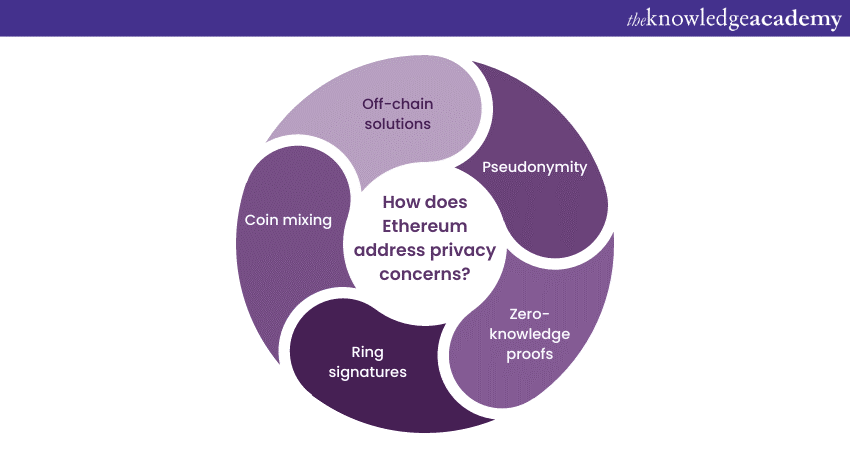
a) Pseudonymity: Ethereum addresses are pseudonymous, not directly linked to real-world identities, providing a level of privacy.
b) Sero-knowledge proofs: Technologies like zk-SNARKs enable the validation of transactions without revealing sensitive data, enhancing privacy in specific use cases.
c) Ring signatures: Privacy-focused Ethereum projects incorporate ring signatures, which obscure the sender's identity by mixing transactions with others, making it challenging to trace back to a single sender.
d) Coin mixing: Ethereum wallets can use coin mixing techniques to obfuscate the origins and destinations of Ether, enhancing privacy.
e) Off-chain solutions: Layer 2 scaling solutions like zk-Rollups and state channels allow for private and efficient transactions while settling the outcome on the Ethereum mainnet.
16) What is a hard cap in Ethereum ICOs?
In the context of Ethereum Initial Coin Offerings (ICOs), a "hard cap" refers to the maximum amount of funds a project aims to raise during its token sale. The hard cap is typically defined in a project's whitepaper or fundraising documentation and serves several purposes:
a) Fundraising limit: It helps the project team determine the maximum amount of capital required to achieve their objectives, such as developing a platform or launching a decentralised application (DApp).
b) Investor confidence: Establishing a hard cap can instil confidence in potential investors by demonstrating a clear financial plan and a commitment to responsible fund management.
c) Token distribution: It ensures that the distribution of tokens remains balanced and prevents a small number of investors from acquiring a disproportionate share of the project's tokens
17) Explain the purpose of Ethereum's gas limit.
The gas limit in Ethereum serves as a critical mechanism to control the computational resources consumed by transactions and intelligent contract executions on the network. The gas limit sets the maximum allowable computational work a trade or brilliant contract execution can perform. Users must specify a gas limit when submitting a transaction, indicating the total amount of gas they are willing to consume. Suppose a marketing or competent contract
execution attempts to exceed this limit. In that case, it will be automatically halted and rolled back, ensuring that no infinite loops or resource-intensive operations disrupt the network.
18) How does Ethereum handle network congestion?
Ethereum employs a dynamic fee market to manage network congestion effectively. When the demand for Ethereum transactions and intelligent contract executions surges, causing congestion, the network adapts through the following mechanisms:
a) Gas price adjustment: Users submitting transactions can choose a gas price they will pay for each gas unit. Users are incentivised to increase their gas prices during congestion to prioritise their transactions. Miners are more likely to include transactions with higher gas fees, encouraging users to bid competitively for network resources.
b) Gas limit regulation: The Ethereum network allows miners to adjust the gas limit for each block based on network conditions. Miners can vote to increase or decrease the gas limit, affecting the capacity of each block. This can help alleviate or exacerbate congestion, depending on miners' decisions.
c) Layer 2 solutions: Ethereum supports Layer 2 scaling solutions like Optimistic Rollups and zk-Rollups, which allow some transactions to occur off-chain, reducing congestion on the leading Ethereum network while maintaining security.
19) What is a Decentralised Autonomous Organisation (DAO) in Ethereum?
A Decentralised Autonomous Organisation (DAO) in Ethereum is a groundbreaking concept representing a digital organisation governed by Smart Contracts and decentralised decision-making.
DAOs typically function as a set of Smart Contracts on the Ethereum Blockchain, where members, or token holders, have voting power proportional to the tokens they hold. These members collectively decide about the organisation's operations, investments, and rules. Proposals and voting mechanisms are coded into Smart Contracts, ensuring that a majority consensus among participants determines outcomes.
20) How does Ethereum prevent double spending of Ether?
Ethereum, like most Blockchain networks, prevents double spending of Ether (ETH) through a consensus mechanism and a transparent transaction history. Double spending is using the same Cryptocurrency twice to make different transactions, a significant concern in digital currency systems. Ethereum employs several vital mechanisms to ensure that each unit of Ether can only be spent once:
a) Blockchain ledger: Ethereum maintains a decentralised and immutable ledger, the Blockchain, which documents all trades chronologically. This ledger is publicly accessible and verifiable by all network participants.
b) Consensus: Transactions on the Ethereum network are validated and counted to the Blockchain via a consensus mechanism, currently Proof of Stake (PoS) in Ethereum 2.0. Validators and miners verify the legitimacy of transactions, ensuring they do not violate double-spending rules.
c) Nonce: Each Ethereum account has a unique sequential number associated with it. The nonce ensures that transactions from an account are processed in the correct order and can only be executed once. This prevents replay attacks and double spending.
21) What is the purpose of the Solidity programming language?
Solidity is a high-level programming language designed explicitly to create innovative Ethereum Blockchain agreements.
The fundamental purposes of Solidity are as follows:
a) Innovative contract development: Solidity is Ethereum's go-to language for creating Smart Contracts, enabling developers to define the logic, rules, and behaviours. It offers an intuitive syntax and comprehensive features for contract development.
b) Security: Solidity incorporates various security features and best practices to help developers write secure Smart Contracts, reducing the risk of vulnerabilities and exploits. This is crucial, as Smart Contracts are immutable once deployed, and any flaws are difficult to rectify.
c) Compatibility: Solidity is Ethereum's native language, making it the most widely supported and compatible language for Ethereum-based and decentralised applications (DApps).
d) Interoperability: Solidity can interact with other Ethereum Smart Contracts and external systems, facilitating complex DApp development and interactions within the Ethereum ecosystem.
22) Explain the term "Gas Price" in Ethereum.
In Ethereum, "gas price" is the cost per unit of computational work or gas needed to complete a transaction or perform a Smart Contract. It is denominated in tiny fractions of Ether (ETH) called "gwei." Users specify a gas price when sending transactions to incentivise miners to prioritise their transactions.
Higher gas prices increase the chances of quicker transaction confirmation, while lower prices may result in slower processing. Miners are motivated to include transactions with higher gas prices in blocks, as they earn these fees as a reward for validating and processing transactions. Balancing gas prices with transaction urgency is essential for efficient Ethereum network interactions.
23) What are ERC-20 tokens, and why are they important?
ERC-20 tokens are a standard for fungible digital assets on the Ethereum Blockchain. They are crucial for creating and managing Cryptocurrencies, facilitating tokenisation, and enabling compatibility with Ethereum-based applications, exchanges, and wallets. This standardisation streamlines token development and enhances interoperability within the Ethereum ecosystem.
24) What is the role of a validator in Ethereum 2.0's Proof of Stake (PoS) system?
In Ethereum 2.0's Proof of Stake (PoS) system, validators replace miners as network participants responsible for securing and validating transactions. Validators are determined based on the portion of Cryptocurrency they lock up as collateral, making them accountable for network security.
Their roles include proposing new blocks, verifying transactions, and participating in consensus by staking their ETH. Validators are economically incentivised to act honestly; otherwise, they risk losing their staked Ether. This PoS mechanism enhances network scalability, energy efficiency, and security while reducing the environmental impact compared to the PoW system used in Ethereum 1.0.
25) Explain the concept of "Casper" in Ethereum.
"Casper" in Ethereum refers to the transition from a Proof of Work (PoW) consensus to a Proof of Stake (PoS) system. Casper is designed to improve the network's scalability, security, and energy efficiency. In PoS, validators are chosen to create and validate blocks founded on the part of Cryptocurrency they have and stand willing to "stake" as collateral.
Casper aims to reduce energy consumption, increase transaction finality, and make the network more environmentally friendly. It is a critical upgrade to Ethereum's infrastructure, aligning with the network's long-term vision for greater efficiency and sustainability.
26) How does Ethereum handle scalability issues?
Ethereum addresses scalability issues through various approaches:
a) Sharding: Ethereum 2.0 introduces sharding, splitting the Blockchain into smaller interconnected chains (shards) to process transactions in parallel, significantly increasing throughput.
b) Layer 2 solutions: Ethereum promotes Layer 2 scaling solutions like zk-Rollups and Optimistic Rollups, enabling off-chain processing while maintaining security and finality.
c) EIP-1559: Ethereum Improvement Proposal 1559 introduces a fee market reform to make transaction fees more predictable and efficient, reducing congestion.
d) Plasma: Research into Plasma technology explores creating child chains for processing transactions separately, further enhancing scalability.
These measures collectively enhance Ethereum's capacity to handle significant transactions and intelligent contract executions, supporting its growth as a robust and scalable Blockchain platform.
27) What is a private Blockchain, and how does it differ from the public Ethereum Blockchain?
A private Blockchain is a restricted, permissioned network where a specific group controls access and participation. Public Ethereum is a decentralised, permissionless Blockchain open to anyone. Private Blockchains offer privacy, centralised control, and efficiency but lack the openness and transparency of public Ethereum, where anyone can participate.
28) Can you name some popular Ethereum development frameworks and tools?
Popular Ethereum development frameworks and tools include:
a) Truffle: A comprehensive development framework with tools for innovative contract development, testing, and deployment.
b) Remix: A web-based integrated development environment for Ethereum Smart Contracts.
c) Hardhat: A flexible development environment for building, testing, and deploying DApps and Smart Contracts.
d) Brownie: A Python-based development framework for Ethereum innovative contract development. Embark A DApp development framework with integration for Ethereum clients like Ganache.
e) Solc: The official Solidity compiler, converting Solidity code into bytecode for execution on the Ethereum Virtual Machine.
f) Web3.js and ethers.js: JavaScript libraries for interacting with Ethereum Smart Contracts and the network.
29) What is the role of the Ethereum Improvement Proposals (EIPs) in the Ethereum ecosystem?
Ethereum Improvement Proposals (EIPs) serve as a standardised method for proposing and discussing changes to the Ethereum network. They facilitate community collaboration, ensuring transparent decision-making and consensus on network upgrades, improvements, and standards, thus driving the evolution of the Ethereum ecosystem.
30) How does Ethereum ensure security in Smart Contracts?
Ethereum ensures security in intelligent contracts through several measures. It promotes using Solidity, a language designed for safety. Developers can employ formal verification to prove contract correctness mathematically. Independent audits identify vulnerabilities.
Testnets allow testing without risking real Ether. Bug bounties encourage security researchers to report vulnerabilities. Once deployed, Smart Contracts are immutable, emphasising the importance of pre-deployment security checks. These combined efforts mitigate risks, enhance code quality, and contribute to the safety and integrity of Ethereum Smart Contracts.
Conclusion
Ethereum's influence continues to grow, shaping the future of decentralised applications, finance, and more. As we conclude this exploration of Ethereum Interview Questions, it's evident that Ethereum's significance transcends its status as a Cryptocurrency platform. Its intelligent contracts, diverse use cases, and vibrant ecosystem make it a powerhouse in the Blockchain world.
By understanding the intricacies of Ethereum, you unlock a world of possibilities, from developing innovative DApps to participating in the broader Blockchain revolution. As Ethereum evolves and new technologies like Ethereum 2.0 emerge, the knowledge shared here serves as a foundation for continued exploration and innovation in the Ethereum ecosystem.
Frequently Asked Questions
Upcoming Programming & DevOps Resources Batches & Dates
Date
 Ethereum Developer Training
Ethereum Developer Training
Fri 10th Jan 2025
Fri 14th Mar 2025
Fri 9th May 2025
Fri 11th Jul 2025
Fri 12th Sep 2025
Fri 14th Nov 2025







 Top Rated Course
Top Rated Course



 If you wish to make any changes to your course, please
If you wish to make any changes to your course, please


